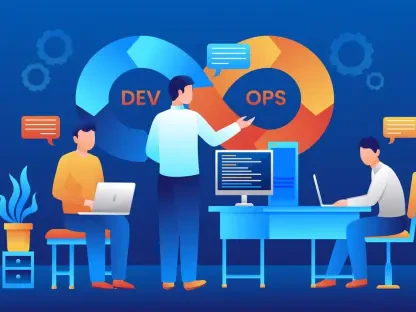The Rise of Secure Containers in Cloud Computing
In an era where cloud infrastructure underpins nearly every facet of digital life, from streaming services to artificial intelligence platforms, a staggering statistic emerges: over 80% of enterprises report security breaches tied to misconfigured cloud environments, highlighting the urgent need for robust solutions. This alarming reality underscores the critical importance of strong security measures as organizations scale their operations to meet escalating demands. Secure containers have risen as a pivotal technology, offering a lightweight yet fortified approach to safeguarding cloud systems, and their adoption signals a transformative shift in how digital ecosystems are protected.
Cloud computing has evolved dramatically, transitioning from the cumbersome architecture of traditional virtual machines (VMs) to the agile framework of container technology. Unlike VMs, which require full operating systems and consume significant resources, containers share the host kernel, enabling rapid deployment and efficient scaling. Secure containers build on this foundation by embedding enhanced protective measures, addressing modern challenges such as real-time threats and compliance requirements while supporting the dynamic needs of industries like logistics and online banking.
Key industry players, including Docker, Kubernetes, and emerging innovators like Minimus.io, are driving technological advancements in this space. Their contributions, alongside developments in orchestration and runtime protection, have positioned secure containers as indispensable for diverse digital services. From powering AI algorithms to ensuring seamless streaming experiences, the significance of this technology lies in its ability to balance speed with safety, making it a cornerstone of contemporary cloud infrastructure.
Key Trends and Market Dynamics in Secure Container Adoption
Emerging Trends Shaping Container Security
A notable trend shaping container security is the emphasis on minimal container images, designed to shrink attack surfaces and boost operational efficiency. By stripping away unnecessary code and libraries, these streamlined images reduce the risk of exploitation and simplify maintenance. This approach has gained traction as enterprises prioritize agility without compromising on protection.
Another critical development is the integration of security into the software development lifecycle through DevSecOps practices. This methodology embeds automated security checks and vulnerability scans from the coding stage, eliminating the delays associated with late-stage fixes. Such proactive measures ensure that containers are secure by design, aligning with the fast-paced nature of cloud deployments.
Innovations like zero-trust frameworks and real-time runtime scanning are also gaining momentum as cutting-edge solutions. Zero-trust principles assume no inherent trust within systems, enforcing strict access controls, while runtime scanning detects threats during operation. Together, these advancements offer a robust defense against evolving cyber risks, reinforcing the resilience of cloud environments.
Market Insights and Growth Projections
Recent studies paint a sobering picture of container security, with reports indicating that 87% of container images still harbor critical vulnerabilities due to excessive components. Data from comprehensive industry analyses highlight the urgency of addressing these gaps, as misconfigurations and oversized images contribute to significant risks. These findings underscore the need for strategic interventions in container design.
On a positive note, minimalist container designs have shown remarkable results in mitigating threats. Research from leading security firms reveals a 65% reduction in risk exposure when non-essential elements are removed from images. This statistic emphasizes the tangible benefits of adopting leaner architectures, which not only enhance safety but also streamline resource allocation.
Looking ahead, market forecasts predict a substantial uptick in secure container adoption over the next few years, from 2025 to 2029. Analysts anticipate that their integration will drive scalability in cloud infrastructure, with secure containers becoming a standard for enterprises aiming to fortify their digital operations. This growth trajectory signals a broader industry shift toward prioritizing security as a fundamental component of cloud expansion.
Challenges in Implementing Secure Containers
The adoption of secure containers is not without hurdles, with one of the primary obstacles being the security risks tied to shared operating system kernels. Unlike VMs, which isolate workloads with separate systems, containers rely on a common kernel, making them susceptible to breaches if not properly configured. This shared architecture demands rigorous isolation mechanisms to prevent cross-container attacks.
Another pressing issue is the prevalence of oversized container images, which often include redundant libraries and code. These bloated images expand the potential attack surface, heightening vulnerability to exploits and complicating patch management. The challenge lies in balancing functionality with minimalism, as excessive trimming can disrupt application performance if not executed with precision.
To address these concerns, solutions such as minimalist designs and automated security checks are gaining prominence. By tailoring images to include only essential components and leveraging tools for continuous scanning, organizations can significantly reduce risks. These strategies, when paired with robust training for development teams, pave the way for safer and more manageable container environments.
Regulatory and Compliance Landscape for Container Security
Navigating the regulatory landscape is a critical aspect of deploying secure containers, with standards such as ISO 27001 and NIST SP 800-190 setting benchmarks for best practices. These frameworks provide guidelines for securing containerized environments, ensuring that organizations adhere to stringent requirements for data protection and system integrity. Compliance with such standards is non-negotiable in regulated sectors like finance and healthcare.
The importance of compliance extends beyond legal obligations, playing a vital role in building trust among stakeholders. Enterprises that demonstrate adherence to recognized standards instill confidence in customers and partners, reinforcing the credibility of their cloud operations. This trust factor is particularly crucial in an era where data breaches can erode brand reputation overnight.
Regulatory requirements also shape the design and deployment of secure containers across industries. From mandating encryption protocols to enforcing audit trails, these guidelines influence how containers are built and monitored. As global regulations evolve, organizations must remain agile, adapting their container strategies to meet emerging compliance demands while maintaining operational efficiency.
The Future of Secure Containers in Cloud Infrastructure
Secure containers are poised to play an integral role in the evolution of cloud systems, particularly as they adapt to cutting-edge technologies like AI, edge computing, and quantum-ready frameworks. Their lightweight nature makes them ideal for distributed environments, where low latency and high security are paramount. This adaptability positions them as a foundational element for next-generation digital services.
Potential disruptors, such as advancements in runtime security and software bill of materials verification, are expected to further elevate container protection. Runtime security tools will enhance real-time threat detection, while verification processes will ensure transparency in container components. These innovations promise to address lingering vulnerabilities, strengthening the overall cloud security posture.
Sustainability also emerges as a key consideration, with minimal containers contributing to reduced energy consumption in data centers. By optimizing resource usage, these containers align with global efforts to lower the environmental impact of technology. As economic and technological trends continue to shape the digital landscape, secure containers will likely evolve to meet both ecological and operational imperatives.
Conclusion and Strategic Recommendations
Reflecting on the insights gathered, secure containers have proven to be a game-changer in bolstering cloud infrastructure security while enhancing efficiency across diverse sectors. Their journey from an emerging concept to a critical asset highlights a fundamental shift in how digital systems are safeguarded against ever-evolving threats. The emphasis on minimalist designs and integrated security practices marks a turning point in addressing long-standing vulnerabilities.
Moving forward, organizations should prioritize the adoption of lean container architectures to minimize risks and optimize resources. Embedding security early in the development process through DevSecOps is essential, as it ensures proactive threat mitigation rather than reactive fixes. Investing in automated tools for continuous monitoring and compliance checks also emerges as a practical step to maintain robust defenses.
Additionally, staying ahead of regulatory changes and technological advancements remains crucial for sustained success. Enterprises are encouraged to explore partnerships with industry leaders and invest in training to build expertise in container security. By taking these actionable steps, businesses can harness the full potential of secure containers, fostering resilience and trust in their digital ecosystems for years to come.









